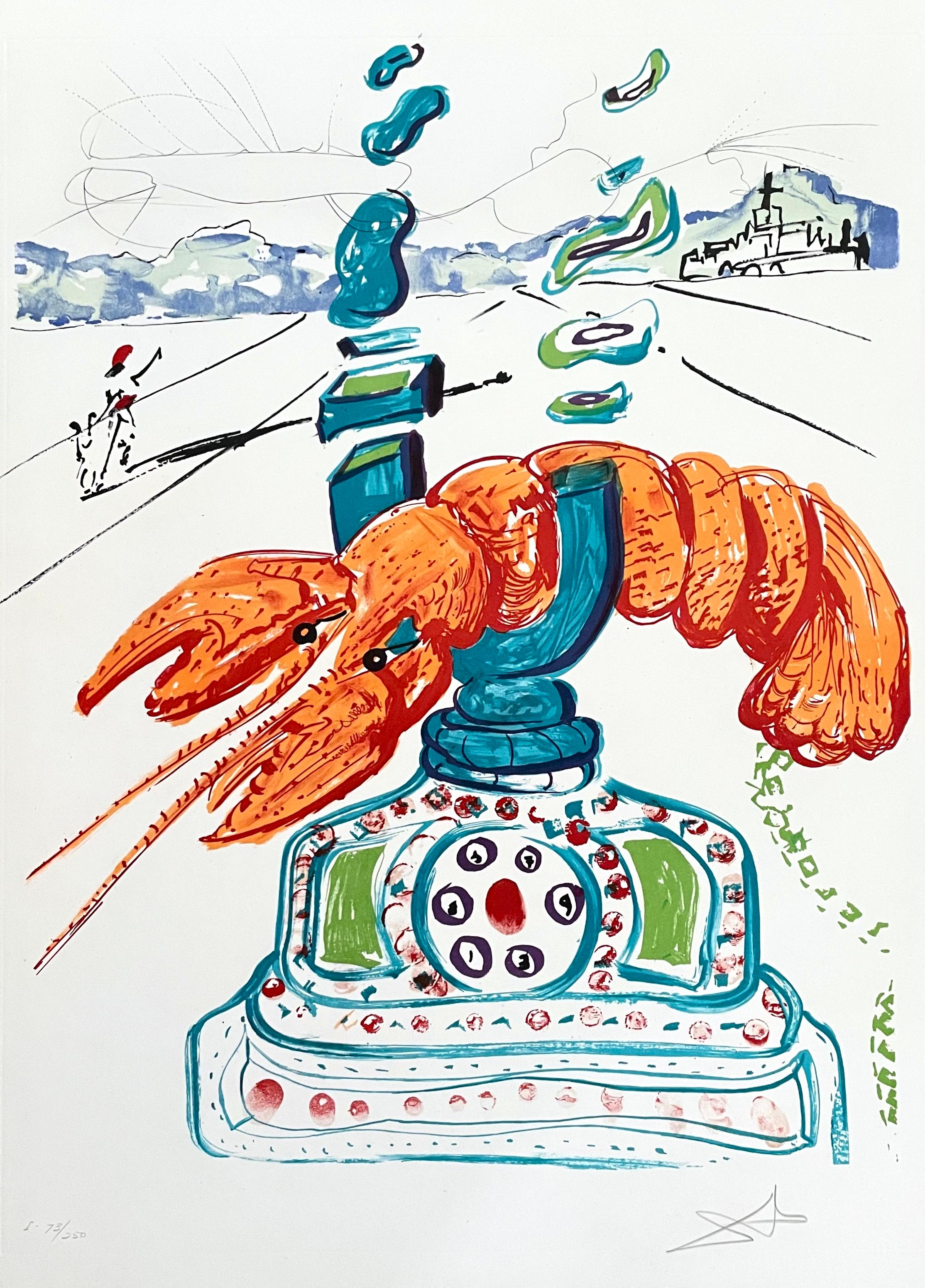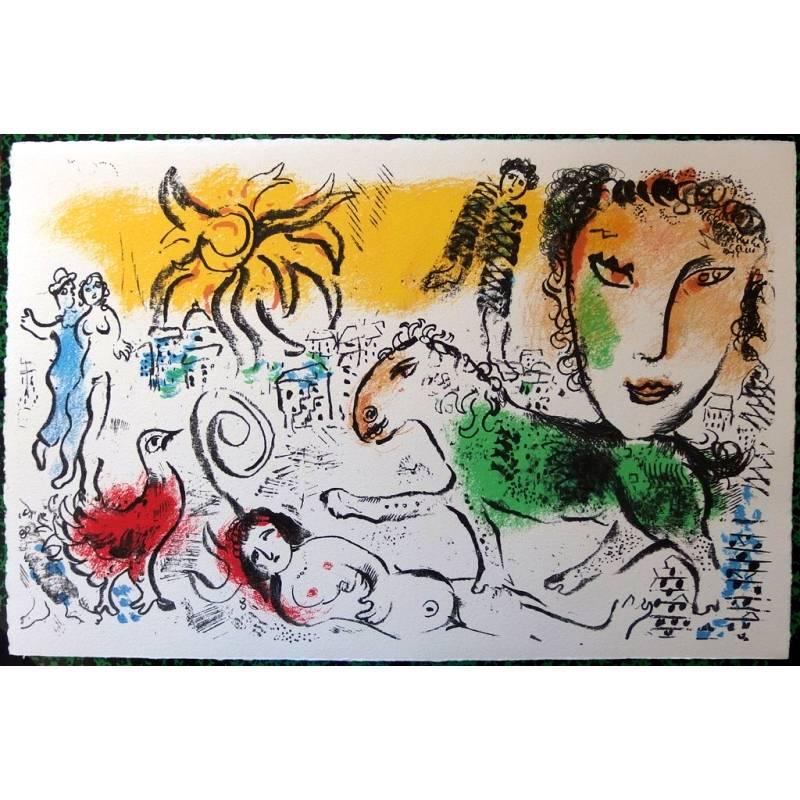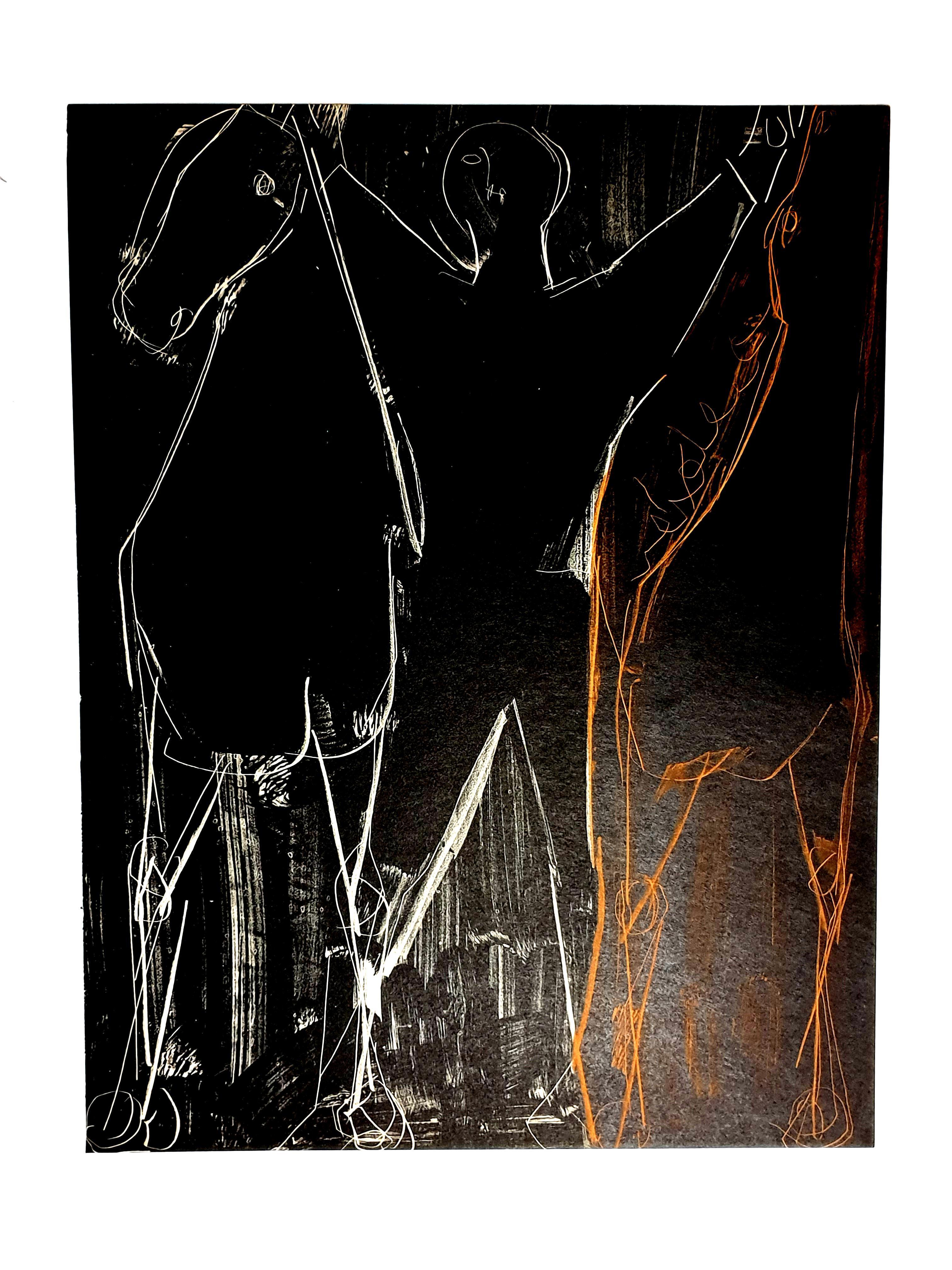Items Similar to La Grande Parade des Chats (The Great Parade of the Cats)
Want more images or videos?
Request additional images or videos from the seller
1 of 10
Leonor FiniLa Grande Parade des Chats (The Great Parade of the Cats)c. 1973
c. 1973
About the Item
Artist: Leonor Fini
Title: La Grande Parade des Chats (The Great Parade of the Cats)
Year: 1973
Medium: Color lithograph
Edition: Numbered 148/230 in pencil
Paper: Wove paper
Image size including border: 12.60 x 9.25 inches
Sheet size: 12.69 x 9.25 inches
Signature: Hand signed in pencil by the artist
Condition: Excellent
Frame: Custom framed in a wooden gold frame, with light creme matting and gold color spacer
About the artist:
Leonor Fini was born in 1907 in Buenos Aires, Argentina of mixed Italian and Slavic descent. She had no formal training in art but like most children, she drew and painted. As a teenager she adorned her efforts with things like crushed eggshell, beads, etc. By the time she was seventeen she was making portraits in oils of well-known people in Triest, which led to an invitation to move to Milan and paint the whole family of a government official. In 1933 she moved to Paris and her work revealed a gift of fantasy that was close to Surrealism.
She also created paintings, posters and sets for the Paris Opera and costumes for the Comedie Francaise. In addition to her work for the Parisian stage, she designed sets and costumes for La Scala opera house. She illustrated several books.
Outspoken and independent, she became part of the surrealist movement along with artists Andre Breton and Max Ernst. She later became known for her images of mysterious exotic young women often portrayed as witches or fairies.
Striking in person as well as in her work, Fini appeared in public in heavy makeup and wearing unusual clothes with wide-brimmed hats and a great deal of jewelry.
She died in Paris in 1996.
The work of Leonor Fini is held in the Galleria Nazionale d’ Arte Moderna, Rome; Musee des Beaux Arts, Grenoble; Musee Royaux des Beaux Arts, Brussels; Museum of Fine Art, Lodz; Peggy Guggenheim Collection, Venice; and the Centre Georges Pompidou, Paris.
- Creator:Leonor Fini (1908 - 1996, French)
- Creation Year:c. 1973
- Dimensions:Height: 20.5 in (52.07 cm)Width: 17 in (43.18 cm)Depth: 0.9 in (2.29 cm)
- Medium:
- Movement & Style:
- Period:
- Condition:
- Gallery Location:San Francisco, CA
- Reference Number:
About the Seller
5.0
Platinum Seller
These expertly vetted sellers are 1stDibs' most experienced sellers and are rated highest by our customers.
Established in 1999
1stDibs seller since 2017
682 sales on 1stDibs
Typical response time: 1 hour
- ShippingRetrieving quote...Ships From: San Francisco, CA
- Return PolicyA return for this item may be initiated within 7 days of delivery.
More From This SellerView All
- "Toad I" from the suite "Bestiary and some Correspondences"By Graham SutherlandLocated in San Francisco, CAThis artwork titled "Toad I" from the suite "Bestiary and some Correspondences" 1967 is an original color lithograph on Arches paper by renown British artist Graham Vivian Sutherland...Category
Mid-20th Century Surrealist Animal Prints
MaterialsLithograph
- "Bird Form" from the suite "Bestiary and some Correspondences"By Graham SutherlandLocated in San Francisco, CAThis artwork titled "Bird Form" from the suite "Bestiary and some Correspondences" 1968 is an original color lithograph on Arches paper by renown British artist Graham Vivian Sutherl...Category
Mid-20th Century Surrealist Animal Prints
MaterialsLithograph
- "Ram's Head, Full Face" from the suite "Bestiary and some Correspondences"By Graham SutherlandLocated in San Francisco, CAThis artwork titled "Ram's Head, Full Face" from the suite "Bestiary and some Correspondences" 1968 is an original color lithograph on Arches paper by renown British artist Graham Vi...Category
Mid-20th Century Surrealist Animal Prints
MaterialsLithograph
- "Sheet of Studies" from the suite "Bestiary and some Correspondences"By Graham SutherlandLocated in San Francisco, CAThis artwork titled "Sheet of Studies, Organic Forms" from the suite "Bestiary and some Correspondences" 1968 is an original color lithograph on Arches paper by renown British artist...Category
Mid-20th Century Surrealist Animal Prints
MaterialsLithograph
- "Ram's Head" from the suite "Bestiary and some Correspondences"By Graham SutherlandLocated in San Francisco, CAThis artwork titled "Ram's Head" from the suite "Bestiary and some Correspondences" 1968 is an original color lithograph on Arches paper by renown British artist Graham Vivian Suther...Category
Mid-20th Century Surrealist Animal Prints
MaterialsLithograph
- "Frontpiece to a Bestiary" From the suite "Bestiary and some Correspondences"By Graham SutherlandLocated in San Francisco, CAThis artwork titled "Frontpiece to a Bestiary" from the suite "Bestiary and some Correspondences" 1968 is an original color lithograph on Arches paper by renown British artist Graham...Category
Mid-20th Century Surrealist Animal Prints
MaterialsLithograph
You May Also Like
- Cybernetic Lobster Telephone (Imagination & Objects), Salvador DaliBy Salvador DalíLocated in Fairfield, CTArtist: Salvador Dali (1904-1989) Title: Cybernetic Lobster Telephone (Imagination & Objects of the Future Portfolio) Year: 1975 Medium: Lithograph ...Category
1970s Surrealist Landscape Prints
MaterialsLithograph, Mixed Media
- Marc Chagall - The Green Horse - Original LithographBy Marc ChagallLocated in Collonge Bellerive, Geneve, CHMarc Chagall Original Lithograph Title: The Green Horse 1973 Dimensions: 33 x 50 cm Reference: This lithograph was created for the portfolio "Chagall Monu...Category
1970s Surrealist Figurative Prints
MaterialsLithograph
- Jean Arp - Original LithographBy Jean ArpLocated in Collonge Bellerive, Geneve, CHJean Arp - Original Lithograph 1951 Dimensions: 32 x 24 cm From the art revue XXe siècle Unsigned and unumbered as issuedCategory
1950s Surrealist Animal Prints
MaterialsLithograph
- Marino Marini - Horses - Original LithographBy Marino MariniLocated in Collonge Bellerive, Geneve, CHMarino Marini - Horses - Original Lithograph 1951 Dimensions: 32 x 24 cm From the art review XXe siècle Unsigned and unumbered as issuedCategory
1950s Surrealist Animal Prints
MaterialsLithograph
- Max Ernst - Elektra - LithographBy Max ErnstLocated in Collonge Bellerive, Geneve, CHMax Ernst - Elektra Lithograph 1939 Dimensions: 32 x 24 cm Signed in the plate From XXe siècle Unsigned and unumbered as issuedCategory
1930s Surrealist Animal Prints
MaterialsLithograph
- Max Ernst - Composition - Original LithographBy Max ErnstLocated in Collonge Bellerive, Geneve, CHMax Ernst - Composition - Original Lithograph 1958 Dimensions: 32 x 24 cm XXe siècle Unsigned and unnumbered, as issued Max Ernst was born in Bruhl, a place near Cologne, in Germany. He was raised in a strict Catholic family, and both of his parents were disciplinarians who were dedicated to training their children into God-fearing and talented individuals. Although his father was deaf, Ernst learned so much from him, particularly when it comes to painting. In fact, much of his early years were lived under the inspiration of his father who was also a teacher. He was the one who introduced painting to Ernst at an early age. In 1914, Ernst attended the University of Bonn where he studied philosophy. However, he eventually dropped out of school because he was more interested in the arts. He claimed that his primary sources of interest included anything that had something to do with painting. Moreover, he became fascinated with psychology, among other subjects in school. Primarily, Ernst's love for painting was the main reason why he became deeply interested with this craft and decided to pursue it later on in his life. During his early years, he became familiar with the works of some of the greatest artists of all time including Claude Monet, Paul Cezanne and Vincent van Gogh. He was also drawn to themes such as fantasy and dream imagery, which were among the common subjects of the works of Giorgio de Chirico. During World War I, Ernst was forced to join the German Army, and he became a part of the artillery division that exposed him greatly to the drama of warfare. A soldier in the War, Ernst emerged deeply traumatized and highly critical of western culture. These charged sentiments directly fed into his vision of the modern world as irrational, an idea that became the basis of his artwork. Ernst's artistic vision, along with his humor and verve come through strongly in his Dada and Surrealists works; Ernst was a pioneer of both movements. It was Ernst's memories of the war and his childhood that helps him create absurd, yet interesting scenes in his artworks. Soon, he took his passion for the arts seriously when he returned to Germany after the war. With Jean Arp, a poet and artist, Ernst formed a group for artists in Cologne. He also developed a close relationship with fellow artists in Paris who propagated Avant-Garde artworks. In 1919, Ernst started creating some of his first collages, where he made use of various materials including illustrated catalogs and some manuals that produced a somewhat futuristic image. His unique masterpieces allowed Ernst to create his very own world of dreams and fantasy, which eventually helped heal his personal issues and trauma. In addition to painting and creating collages, Ernst also edited some journals. He also made a few sculptures that were rather queer in appearance. In 1920s, influenced by the writings of psychologist Sigmund Freud, the literary, intellectual, and artistic movement called Surrealism sought a revolution against the constraints of the rational mind; and by extension, they saw the rules of a society as oppressive. Surrealism also embraces a Marxist ideology that demands an orthodox approach to history as a product of the material interaction of collective interests, and many renown Surrealism artists later on became 20th century Counterculture symbols such as Marxist Che Guevara. In 1922 Ernst moved to Paris, where the surrealists were gathering around Andre Breton. In 1923 Ernst finished Men Shall Know Nothing of This, known as the first Surrealist painting. Ernst was one of the first artists who apply The Interpretation of Dreams by Freud to investigate his deep psyche in order to explore the source of his own creativity. While turning inwards unto himself, Ernst was also tapping into the universal unconscious with its common dream imagery. Despite his strange styles, Ernst gained quite a reputation that earned him some followers throughout his life. He even helped shape the trend of American art during the mid-century, thanks to his brilliant and extraordinary ideas that were unlike those of other artists during his time. Ernst also became friends with Peggy Guggenheim, which inspired him to develop close ties with the abstract expressionists. When Ernst lived in Sedona, he became deeply fascinated with the Southwest Native American navajo art. In fact, the technique used in this artwork inspired him and paved the way for him to create paintings that depicted this style. Thus, Ernst became a main figure of this art technique, including the rituals and spiritual traditions included in this form of art. Pollock, aside from the other younger generations of abstract expressionists, was also inspired by sand painting of the Southwest...Category
1960s Surrealist Animal Prints
MaterialsLithograph





